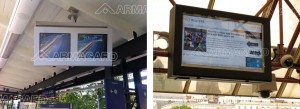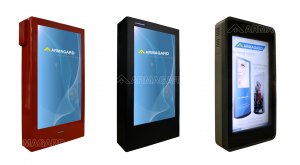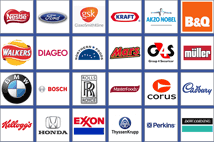LCD/LED Transport Displays
Digital signage displays are used to communicate all types of travel information these days, facilitating our need for accurate and on-demand information. Digital displays have become a powerful tool for reaching a moving audience. However, while prices for indoor monitors have reduced because of advancing technology, finding an outdoor solution still involves premium pricing for dedicated, but inflexible weatherproof LCD units.

Double 19 inch enclosure used in a Swedish subway station. (Armagard, 2012) Delhi Train Station 42 inch flat panel enclosure (Armagard, 2010)
Before today’s digital methods of communication, transport information would simply be shown through chalk boards, display stands, or asking an attendant.
But as technology costs reduce, and new digital alternatives like LCD and LED displays become more available, the use of timetable displays has become a standard for most transport services, such as airports and train stations. These displays not only allow travel companies to have a constant flow of communication and enhance passenger experience, but open channels for mass promotion and advertising revenue.
Applications
Seen in some capacity almost every day, timetable displays have become a necessity for travel; even across relatively short distances, but as populations grow and commuting increases, digital signage displays have become a prerequisite for developing travel structures. Used in indoor, semi-outdoor and outdoor areas, timetable displays have to be secure enough to cover a range weather conditions, accidental damage, and even vandalism. Luckily enough, outdoor transport displays are highly versatile, and are appropriate for a variety of locations, such as.
• Flight Arrivals and Departures
• Bus & Rail Stations Platforms
• Motorway Safety Updates
• Baggage Reclaim
• Car Parking Availability
• Sailing Times
Advantages
Communicating to a growing mass audience, digital technology has advanced to the point where it has several benefits over traditional media. LED and LCD technology is currently the most commonly used display type used transport, however, varying in degrees of effectiveness; such displays have both advantages and disadvantages.
• Scalable Text – Information can be read from further away.
• Backlit Displays – Text can be read in low or dim light.
• Translations – Language can be alternated.
• Remote Updates – Update content from a computer.
In addition, digital displays can be placed above head-height, reduce the number of questions asked to staff, lower queue times, and ease the flow of traffic.
Disadvantages
Unfortunately, unlike traditional print media, digital displays can be problematic. Vulnerable to several issues, if a fault does occur, repairs can be costly and time consuming.
• No Protection – Downed displays, cause chaotic information failures.
• Install technicians – Dedicated outdoor displays, require specialised call out engineers
• Vandal Attacks – High traffic areas, where vandalism chances are high.
• Weathering – Outdoor displays have to withstand cold, heat and high winds.
Outdoor LCD Display Vs LCD Enclosures
One option for an outdoor environment is a dedicated waterproof LCD /LED screen; however, such units are expensive, making them a risky investment for smaller companies. In addition, many of these displays only cater for waterproofing, and do not support features to control heat, direct sunlight or vandalism, leaving their long-term functionality in question.
If a fault does occur, an engineer call-out may also be necessary, meaning a broken display could be down for days, and in the worst case need to be sent back for repair.
Another option is to use a protective flat panel enclosure. LCD enclosures can be integrated with most commercial grade displays (with a VESA mount), sealed to IP56, and are durable against the effects of heavy rain, dust, extreme temperatures and heavy impacts.
A great solution for areas that need cost efficient outdoor protection, enclosures can be installed for both indoor and outdoor screens, offer an all-in-one solution with easy setup, and unlike outdoor displays, if a breakdown occurs, an LCD monitor can be easily swapped out.
Monitoring the interior temperature of the enclosure is just as important to support hardware efficiency, so Armagard uses environmental control, which employs key interior components like fans, heaters and insulation that regulate and control electrical hardware to keep the enclosure working as efficiently as possible.
Taking chances with such factors will often lead to eventual display failure, and for intensive applications like transport signage or safety information, the risk of a potential breakdown could be disastrous to scheduling and safety.
Dealing with these common failures is easily avoidable, and with the right hardware choices from heating to fan ventilation, Armagard specialise in providing specialised solutions for a range of different environments.
Armagard Installations
With experience in transport installations, Armagard have outfitted numerous locations for both indoor and outdoor lcd housing, used by thousands each day some of their installations include.
• New Delhi Train Station
• Birmingham & Heathrow Airport
• East Midlands Train Station
• Georgia Bus Station
• Swedish Train Station

3 enclosure designs, Portrait enclosure have been installed in Birmingham airport and the East Midlands train stations.
Optimised to make information clear and easy to read, popular designs and orientations include the portrait flat panel enclosure (shown above), landscape outdoor plasma, and the unique double enclosure.







